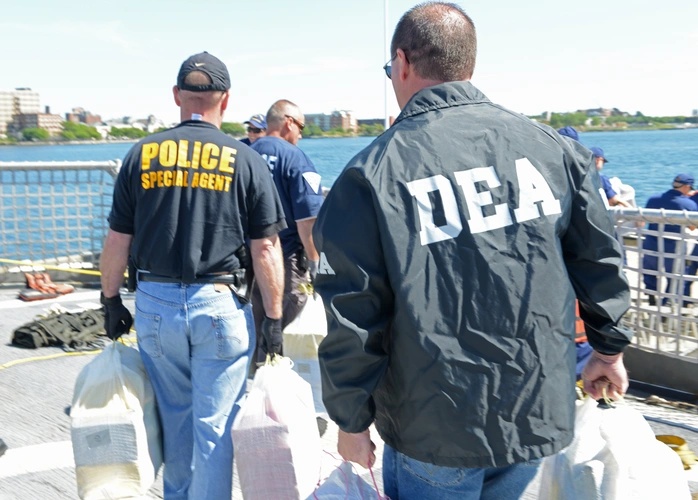An Increasingly Difficult Migration Climate
It’s a sticky-hot Sunday night in Tenosique, Tabasco, and Josue is carefully massaging powder onto his feet. “Do your feet hurt?” he asks, catching my gaze and offering the bottle in my direction. Mine did not, but unlike Josue, I had not spent the previous two days walking 37 miles from the Mexico-Guatemala border and dodging the Mexican immigration authorities along the way.
Published by The Lawfare Institute
in Cooperation With

It’s a sticky-hot Sunday night in Tenosique, Tabasco, and Josue is carefully massaging powder onto his feet. “Do your feet hurt?” he asks, catching my gaze and offering the bottle in my direction. Mine did not, but unlike Josue, I had not spent the previous two days walking 37 miles from the Mexico-Guatemala border and dodging the Mexican immigration authorities along the way.
We are both sitting in the dark at La 72 migrant shelter, the first stop in 20-year-old Josue’s journey north to Mexico City. Around us, another 100 or so migrants—mostly from Honduras—are also sprawled across chairs and the ground, watching the weekly Sunday night movie before heading north on the migratory route that stretches across Tabasco, Veracruz, Puebla, and Estado de México. It’s a tranquil scene, but one that is constant shifting—not just from the transitory population but also from the rapidly changing local, regional, and international policies. 
Over the past year, the most evident change is that fewer Central American migrants are attempting the journey through Mexico. Not only are there smaller numbers of people in the La 72 shelter, but Mexico's immigration authorities report a 50 percent drop in total migrant apprehensions since this past November. The drop is even higher at the U.S.-Mexico border, where the number of migrants apprehended has fallen by 75 percent during the same time period.
The decreasing number of Central American migrants crossing through Mexico has been at least partially attributed to the “Trump effect”—an all-encompassing term that includes everything from President Donald Trump’s hostile rhetoric about migrants to deterrence caused by of stepped up immigration enforcement to more generalized fears of new anti-immigration policies. The idea is that migrants are more hesitant to leave their homes if they believe that they will be immediately deported. This is particularly powerful when combined with more specific policy proposals or rumors about these proposals, such as plans to separate mothers and children at the U.S.-Mexico border or to block asylum seekers at ports of entry (which, as Human Rights Watch documents in this May 2017 report, is already happening).
Yet it’s not just the rumors that keep migrants at home; it’s also the rising smuggling costs. The expectation of dramatic policy changes under the Trump administration have pushed up the Central America - United States smuggling rate from $6,000 pre-Trump to up to $10,000 today. This pricey service, preferred by families for being the quickest and safest way north, often covers a five to seven-day trip in which migrants are packed en masse into trailers and driven across Mexico. It also includes the bribes to pay off officials or criminal groups along the way.
For migrants who can’t scrabble together $10,000, there are two options.
The first possible choice is to set their sights on countries closer to home. This is reflected in the increasing number of Central American refugee applications in Mexico, which totaled 3,543 for the first three months of 2017 and is on pace to surpass last year’s application rate by at least 60 percent. It’s also increasingly apparent as migrants state Mexico City or Monterrey as their final destination. Most will readily admit that this opinion is not as appealing as the idea of reaching Los Angeles or New York City, but for those who leave their towns with the equivalent of just a few hundred pesos (less than $20) tucked into a sock, it’s a dream that feels much more obtainable.
The second alternative is to set out to the United States with cheaper smugglers or alone on foot, bus, or train. This isn’t a particularly attractive option for many would-be migrants given the dangers that await them or the high chances of being picked up and deported by Mexico’s migration authorities. Yet each year, tens if not hundreds of thousands of migrants decide to try their luck.
Migrants are well aware of the risks they face, and share stories and tips with one another along the way. In the La 72 shelter, migrants explained to me the points on the highways and rail tracks where one can expect robberies or sexual assaults; they highlighted the places where criminal groups board the trains to demand money and the consequences that come to those who can’t pay (among the best outcomes is being thrown off the moving train and landing in a grassy spot); and they outlined the very real threats of kidnapping and torture in places further to the north. They were also aware that if they disappear along the way, their deaths will most likely go unnoticed or be marked by an anonymous blip in a local paper’s crime beat.
These are far from a handful of isolated anecdotes. A May 2017 Doctors Without Border’s report added numbers to the crimes, documenting that since 2013, roughly two thirds of the migrants treated by the organization had been victims of some form of violence, and one third of the women had been sexually abused (60 percent of these women had been raped). And these are only the migrants who survive. At least some of the bone shards found in the clandestine graves across Mexico belong to Central American migrants who disappeared along the routes.
Mexican authorities have pledged to help protect migrants from these and other abuses. Yet, their simultaneous efforts to secure the border and increase immigration enforcement—which, since the July 2014 announcement of the country's border plan, Programa Frontera Sur, has focused on keeping migrants off the trains and led to the apprehension of over 480,000 migrants—have frequently done the opposite.
This was readily apparent when the train finally arrived in Tenosique after five long days. The migrants in the La 72 shelter who were planning to board the train were met by migration authorities who barred them from clambering onto the top of the cars. Tired of waiting and unsure when they would be able to board the train, groups of migrants—including Josue—decided to walk the rails, heading toward the second train stop at Palenque in what is a grueling three-day hike. Beyond the jungle humidity and heat in Tabasco that tops 100 degrees in the summer, these migrants, alone on the tracks, are even more exposed to criminal exploitation.
Knowing these risks and odds, it then might seem counterintuitive that anyone would ever choose to try his or her luck at traveling through Mexico. Yet, all migrants have specific reasons that brought them to this decision. In fact, there are perhaps only two constants throughout the many stories. First, that behind each migrant there is a desperation or restlessness—borne out of fear, abuse, poverty, homelessness, or starvation, among other reasons—that has to be so profound that gambling it all is actually more rational than staying put. Second, that they did not have a legal pathway from within their countries to reach their final destinations. For undocumented immigrants like Josue, it’s not about cutting to the front of immigration lines; it’s simply that there aren’t any lines.
For decades now, immigration enforcement policies have not addressed these structural issues and have been stubbornly stuck on the easiest—and most superficial—approaches. They focus on building walls, pulling people off trains, and hiring more border patrol agents. They demand orderly immigration without creating the lines that would allow people the option of legal movement. They deport criminals to Central America without inter-governmental coordination and then criminalize the migrants who run away from these gangsters’ crimes. And they denounce migrants for stealing U.S. and increasingly Mexican jobs, without touching the companies that hire them, without investing in job creation in Central America, and without pressuring the region’s governments to enact and enforce the necessary economic and anticorruption reforms.
This outcome isn’t particularly surprising, given the treacherous domestic politics at play: comprehensive immigration reform has been politically dead in the United States for years; relatively few Americans or Mexicans would accept any other outcome for undocumented criminals beyond a swift deportation; and rounding up millions of migrants or truly barring their labor would tank many companies, big and small.
However, in the void left by any meaningful action, there is a temptation to focus on suppressing the symptoms of these structural issues, measuring immigration policies’ success only through metrics like the number of apprehensions or deportations, and proclaiming victory with each rising number. Yet, continuing to promote this narrative also has consequences. It distorts the U.S. national discourse and budget priorities, and perpetuates regional market inefficiencies, increases revenue sources for transnational criminal groups, and generates an ever growing pool of human misery.
Before he left the La 72 shelter, Josue handed me the names of his town and father in Honduras, memorized my phone number, and promised to call me when he arrived at the migrant shelter in Palenque. It’s been two weeks since our goodbye and I never got that call. Josue, in the footsteps of the millions of Central Americans who came before him and the many that will follow, is now just one more migrant who has gone silent along the way. His story stands as a tiny detail in the ever-shifting regional migration dynamics, a data point to explain and measure today’s enforcement policies, and a reminder of the complex immigration challenges that still lie ahead.



.png?sfvrsn=48e6afb0_5)

